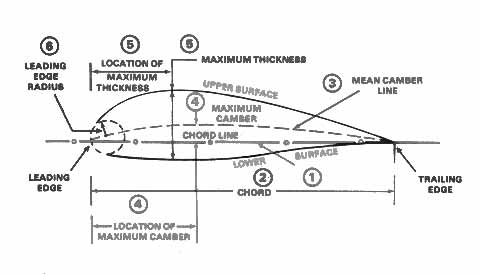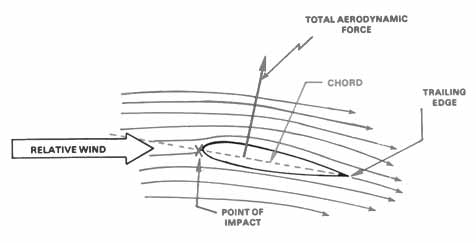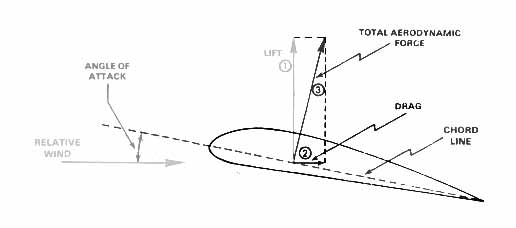General:
~ aerodynamic forces are produced when air passes about the rotor blades
~ rotor blade's shape produces lift to helicopter when it passes through the air
~ blades have sections designed for a specific set of flight characteristics
~ they must adapt to a wide range of airspeeds and angles of attack during each revolution of the rotor
~ designer's challenge: blade that has the best flight characteristics for the missions helicopter is planned to fly
Symmetrical blades:
~ have identical upper and lower surfaces and almost no center of pressure travel
~ travel remains relatively constant under varying angles of attack, affording the best lift-drag ratios for the full range of velocities from rotor blade root to tip
~ produce less lift than a nonsymmetrical blade
~ have relatively undesirable stall characteristics
~ deliver acceptable performance
~ cost less and are easier to construct
Nonsymmetrical (cambered) blades
~ have a wide variety of upper and lower surface designs
~ are increasingly being used on newly designed aircraft
~ offer increased lift-drag ratios and more desirable stall characteristics
~ new design processes and materials used to manufacture rotor systems have partially overcome the problems associated with use of nonsymmetrical blades
Blade Sections
~ the speed of a blade is a combination of blade rotation and forward movement of the helicopter
~ blades are designed with specific geometry that adapts them to the varying conditions of flight
~ cross-section shapes of most rotor blades are not the same throughout the span
~ shapes vary along the blade radius to take advantage of the particular airspeed range experienced at each point on it & to help balance the load between the root and tip
~ blade may be built with a twist, so a blade section near the root has a larger >pitch angle than a section near the tip

Figure: Blade terminology @~copters
1) Chord_Line:
a straight line connecting the leading and trailing edges of the blade
2) Chord:
the length of the chord line from leading edge to trailing edge and is the characteristic longitudinal dimension of the blade
3) Mean_Camber_Line:
~ a line drawn halfway between the upper and lower surfaces
~ chord line connects the ends of the mean camber line
~ the shape of the mean camber is important in determining the aerodynamic characteristics of an blade section
4) Maximum_Camber:
displacement of the mean camber line from the chord line
5) Maximum Thickness:
expressed as fractions or percentages of the basic chord dimension
6) Radius_Leading_Edge:
the radius of curvature given the leading edge shape
Airflow around blades
 @~copters
@~copters
Figure: Airflow around blade @~copters
~ a total aerodynamic force is generated when a stream of air flows over and under a blade that is moving through the air
~ the point at which the air separates to flow about the blade is called the point of impact
~ a high pressure area or stagnation point is formed at the point of impact
~ normally the high pressure area is located at the lower portion of the leading edge, depending on angle of attack
~ this high pressure area contributes to the overall force produced by the blade
~ the air is deflected downward as it passes under the blade and leaves the trailing edge
~ Newton's third law states "every action has an equal and opposite reaction"
~ since the air is being deflected downward, an equal and opposite force must be acting upward on the blade
~ this force adds to the total aerodynamic force developed by the blade
~ at very low or zero angles of attack, the deflection force or impact pressure may exert a zero positive force, or even a downward or negative force
~ air passing over the top of the blade produces aerodynamic force in another way
~ the shape of the blade causes a low pressure area above the blade according to Bernoulli's Principle,
~ and the decrease in pressure on top of the blade exerts an upward aerodynamic force
~ pressure differential between the upper and lower surface of the blade is quite small - in the vicinity of 1 percent
~ however, even a small pressure differential produces substantial force when applied to the large area of a rotor blade
Forces acting on blade

Figure: Forces acting with blades @~copters
1) Lift:
~ acts on the blade in a direction perpendicular to the relative wind
~ increased speed causes increased lift because a larger pressure differential is produced between the upper and lower surfaces
~ does not increase in direct proportion to speed, but varies as the square of the speed
~ blade traveling at 500 knots has four times the lift of the same blade traveling at only 250 knots
~ blade area of 100 square feet will produce twice as much lift as a blade area of only 50 square feet
~ increases as the angle of attack increases up to the stalling angle of attack
~ stall angle varies with different blades and is the point at which airflow no longer follows the camber of the blade smoothly
~ air density directly influences lift
2) Drag:
~ is the resistance or force that opposes the motion of the blade through the air
~ acts on the blade in a direction parallel to the relative wind:
3) Total aerodynamic force:
~ is sometimes called the resultant force
~ can divided into two components: 1) lift and 2) drag
catch ~>Helicopter ~>Xi ~>Formulas!

 @~copters
@~copters
